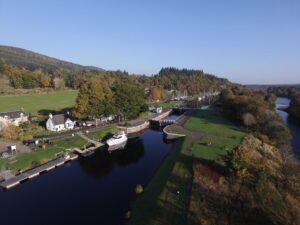 Kayak on the Caledonian Canal
Kayak on the Caledonian Canal
Kayak on the Caledonian Canal with Loch Ness Kayak. We offer great beginners kayak trips from Dochgarroch on the Caledonian Canal to Loch Ness. Starting point isonly 4 miles from Inverness.
Scottish Canals manage the canal today and it is over 200 years old. The Caledonian Canal stretches for 60miles (97km) from Inverness to Fort William, through the Great Glen fault. It was originally built to allow safe traffic during the Napoleonic Wars, to protect ships from having to go round Scotland by the Pentland Firth and also to create work for displaced Highlanders and relieve poverty in a similar way to the so called Destitution Roads. The plan was also to encourage trade from east and west with Germany, Holland and Scandinavia.
James Watt developed the first plans in 1773 and the work was begun by Thomas Telford and William. Jessop in 1803. Neptune’s Staircase at Banavie with its rise of 80ft/24m was the greatest engineering challenge. The canal was opened in 1822 but had to be deepened, and work was finally completed in 1847.
It joins Loch Dochfour, Loch Ness, Loch Oich, Loch Lochy and Loch Linnhe with 20 locks, the most famous being the eight locks of Neptune’s Staircase.
The canal was predicted by the Brahan Seer who said that one day tall ships would sail around Tomnahurich Hill in Inverness. The canal is now used only by pleasure boats and the occasional fishing boat. Alongside is the Great Glen cycle track, which makes use of Wade’s road and the canal towpaths.
The high point was in 1835 when 544 ships passed through and it was seen as of value to the fishing fleet but it certainly helped the revitalisation of the Highlands.
Thomas Telford engineered much of the canal. Thomas Telford was described as the ‘Colossus of Roads’ by his friend, the poet Robert Southey. Telford, a shepherd’s son, was born in Westerkirk, Dumfriesshire. He had no formal further education but was apprenticed to a stonemason who carved tombstones. When the Duke of Buccleuch built the planned village of New Langholm, Telford learned house building, and his bridge over the River Esk is extant. By 1779 he was involved in Edinburgh’s New Town.
Although the canal was built to allow safe traffic during the Napoleonic Wars, it actually had no military function until World War I. The canal was fully publicly funded and was therefore the first example of nationalised transport in the UK. It was Britain’s first ship canal and intended to be 20ft/7m deep and 110ft/37m wide.
There are 28 locks in total, the maximum draft is 18ft/6m. Neptune’s Staircase at Banavie with its rise of 80ft/27m was the greatest engineering feat.
Brief History
1773. The canal was conceived. The route was first surveyed by James Watt in 1773.
1803. Act of Parliament was passed authorising the construction of the canal. Thomas Telford was asked to survey and build the canal with the help of William Jessop. The work was expected to take 7years to complete at a cost of £474,000.
1815. Napoleon was defeated at the battle of Waterloo and the perceived threat to British Naval shipping was gone.
1822. The 22-mile canal with its 29 locks was open. It had taken 12 years to build at a cost of £910,000.
1873. Queen Victoria took a trip along the canal.
1914-1918. Shipping increased during WWI as vessels tried to avoid the German Navy patrolling of the Northern coasts of Scotland.
1920. Ownership of the canal was transferred to the Ministry of Transport.
1930s. Paddle steamers like the Glengarry and Gondolier, operate busy passenger services along the Great Glen.
1962. Ownership of the canal transferred to the newly created British Waterways.
1995. Major restoration works are undertaken for the next 10 years.
2005. Canal reopens.
Enjoy a kayak on the Caledonian Canal with Kayak Loch Ness.
[checkfront category_id=”14″ options=category_select]

Comments are closed